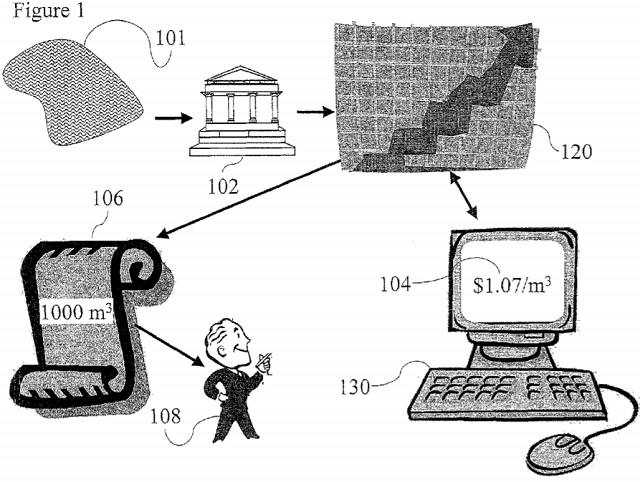This is a further decision that confirms that business-related aspects of the claimed subject-matter cannot contribute to inventive step. Here are the practical takeaways from the decision T 0426/16 of 17.9.2020 of Technical Board of Appeal 3.4.03:
Key takeaways
Remember that the so-called "contribution approach", taking into account prior art when determining whether subject-matter was excluded under Art. 52(2) and (3) EPC 1973, is abandoned (Case Law of the Boards of Appeal of the European patent office, I.A.1.4.1 a) and b)
It must be clear from the wording of the claim or the application that technical means must actually be used to carry out a method step.
The invention
The invention underlying the present decision relates to an investment instrument for water based on a stable free market price. A broker computes an index value of water 104 (1.07 $ per m3, for example), which allows to evaluate a defined portion of the body of the water. Then, the broker may sell a certificate for 1000 m3 of water for 1000 m3 x 1.07 $/m3 = 1070 $ (plus, for example, a 2% commission) to an investor. The relevant factors for computing the value index of the water are regularly updated. Furthermore, the state of a collateral is periodically appraised by a "professional appraiser" and the value of the collateral adjusted in order to make sure that each certificate is covered by valid assets.

Fig. 1 of WO 2009/024928 A2
Here is how the invention was defined in claim 1:
Claim 1 (main request)
(a) A method of determining and using a professional appraisal of a water quality of an amount of water, comprising:
(b) professionally appraising, by means of professional water quality appraisal instruments, the amount of fresh water to determine a categorization of the amount of fresh water, into at least two of the following water quality categories (i) domestic water, (ii) desalinated water, (iii) bottled water or (iv) purified water;
(c) determining, and storing on one or more computers the results of said determining, at least one of a quantity of water utilized to produce a quantity of at least one first product other than water and a quantity of water constituent in the quantity of the at least one first product;
(d) constantly monitoring a varying price, P1, of at least one product other than water and constantly providing one or more processors with the varying price P1 of the at least one first product;
(e) configuring one or more processors to determine and repetitively adjust a first index value applied to the amount of fresh water based on changes in the constantly provided varying price P1 of the at least one first product and based on at least one of (i) a quantity of water utilized to produce a quantity of the at least one first product and (ii) a quantity of water constituent in the quantity of the at least one first product,
(f) configuring the one or more processors such that adjustments in the index value are made at least daily to reflect any changes in P1,
(g) instructing digital display devices to display an adjusted first index value in real time when the one or more processors determine a change in P1; and
(h) determining a value of a defined portion of the amount of water, by the one or more processors, by taking into consideration the professionally appraised water quality category of the amount of water and the determined first index value or adjusted first index value; and
(i) determining, and storing on one or more computers the results of said determining, a quantity of water utilized to produce a quantity of at least one second product other than water and a quantity of water constituent in the quantity of the at least one second product;
(j) constantly monitoring a varying price, P2, of at least one second product other than water and constantly providing one or more processors with the varying price P2 of the at least one second product;
(k) configuring one or more processors to determine and repetitively adjust a second index value applied to the amount of fresh water based on changes in the constantly provided varying price P2 of the at least one second product and based on at least one of (i) a quantity of water utilized to produce a quantity of the at least one second product and (ii) a quantity of water constituent in the quantity of the at least one second product,
(l) configuring the one or more processors such that adjustments in the second index value are made at least daily to reflect any changes in P2,
(m) instructing digital display devices to display an adjusted second index value in real time when the one or more processors determine a change in P2; and
(n) determining a value of a defined portion of the amount of water, by the one or more processors, by taking into consideration the professionally appraised water quality of the amount of water and the determined second index value or adjusted second index value.
Is it patentable?
At the end of the first instance prosecution stage, the examining division decided that the subject-matter of the independent claims of the main request (and of first to third auxiliary requests) lacked an inventive step in view of a notoriously-known computer network system. In more detail, most of the claimed features were ignored for the assessment of inventive step since they were considered non-technical:
4.1 The examining division decided that the subject-matter of the independent claims of the main request and of the first to third auxiliary requests, all filed on 10 August 2015, lacked an inventive step (Article 56 EPC) in view of a notoriously known computer network system. The technical features of the method claim 1 of the requests were no more than a notoriously known "computerized system", see sections 12.3 and 12.4 of the contested decision. The step of "professionally appraising fresh water in regard to the quality and quantity", the steps of determining and repetitively updating an index value (based on changes on the price of a product, the quantity of water utilized to produce the product and the quantity of water constituent in the product) and the step of determining a value of the collateral using the computed index value and the appraised quality/quantity of the collateral were considered as related to "a business concept on an abstract level", see sections 12.2.
Against this decision, the applicant filed an appeal and argued that a water quality appraisal instrument is a technical means (hereinafter first argument). In addition, the applicant argued that, according to some decisions of various Boards of Appeal, in order to be patentable, it is sufficient that the claimed subject-matter is based on technical considerations (hereinafter second argument):
(d) According to the appellant, the claims recited a non-abstract technical solution with a technical character and, hence, provided a technical solution to a technical problem. In view of the "professional water quality appraisal instruments" in the independent claims, the skilled person was "an expert in the field of technical evaluation of substances in the water by technical instruments", which "could not be interpreted as an abstract mental or pure business act that can even be performed by a human being". Features (b) and (b') therefore were technical features. As examples of an "professional water quality appraisal", the appellant mentioned the measure of the amount of one or more substances in water e. g. to determine its salinity or its pH, the term "water quality" being a known "technical characteristic". The appellant cited a number of web pages related to the testing of water quality.
(e) The appellant argued that the "water quality appraisal instruments" were "integrated together with the inventive combination of elements" according to features (h) and (n) or (h') and (n'), because for determining the "value of a defined portion of the amount of water" the first (or second) index and the appraised water quality (category) were taken into consideration.
(g) The appellant mentioned decisions T 931/95 and T 769/92, where the Board of Appeal held "allowable a method claim based merely on an implied need for technical considerations". The Board in case T 769/92 found that the invention had technical character because it implied a need for technical considerations when carrying out that invention.
However, the board in charge did neither follow the first nor the second argument. With respect to the first argument, the board argued:
No indication can be found in the application as originally filed for "professional water quality appraisal instruments" according to features (b) and (b'). "Professional water quality appraisal instruments" are neither explicitly mentioned on page 6 nor can they be derived therefrom. Page 8, lines 9 to 10, lines 17 to 22 and figure 2, box 236 merely mention that a "professional appraiser appraises (box 236) the collateral for the quantity, the quality and availability of the water". From this passage, a skilled person reading the application as originally filed cannot directly and unambiguously derive that "professional water quality appraisal instruments" are involved or what kind of analysis (salinity, pH or other) is performed. The Board understands from page 8, lines 17 to 24 that step 236 in figure 2 concerns an evaluation by a professional of the state of the collateral 101, e. g. a lake. However, no indication can be found in the application that this evaluation requires any "professional water quality appraisal instruments".
[...]
Hence, the application as originally filed does not disclose "water quality appraisal instruments" as such or does not suggest that the professional appraisal mentioned on page 8, lines 17 to 22 is necessarily performed by using technical means.
On the second argument, the board in charge commented as follows:
4.6 Regarding the appellant's comments on T 769/92, see section VII., point (g), the Board notes that this decision concerned the question whether the claimed subject-matter was covered by the exclusion provisions of Article 52(2) and (3) EPC and still followed the now abandoned "contribution approach", see e. g. Case Law of the Boards of Appeal of the European patent office, I.A.1.4.1 a) and b). A discussion of the contribution approach and the departure from it can be found e. g. in G 3/08, points 10.6 and 10.7 of the Reasons for the Opinion. In the present case, the examining division did not question that the subject-matter of the claims was not falling within the exclusions of of Article 52(2) and (3) EPC. Furthermore, the Board in T 769/92 found that technical considerations were necessary before programming of the computer-implemented method could begin. In the present case, no technical considerations are to be made, as each consideration appears to be made by a broker, and not a computer engineer.
4.7 Hence, in view of sections 4.3 to 4.6 above and of the example of figures 1 to 3, the Board is of the view that the only technical features disclosed in the application as a whole and present in the above subject-matter are a notoriously-known computer with a processor, a memory and a display. As a side remark, the Board notes that a basis for a method involving or a system having plural computers, plural processors or plural display devices is not disclosed in the application as originally filed, figure 1 only showing one desktop computer with a processor, a memory and a display device.
Therefore, the board concluded that claim 1 of the main request did not involve an inventive step. Furthermore, since the same arguments would also apply to the subject-matter of all filed auxliary requests, the appeal was dismissed.
The content of this article is intended to provide a general guide to the subject matter. Specialist advice should be sought about your specific circumstances.

